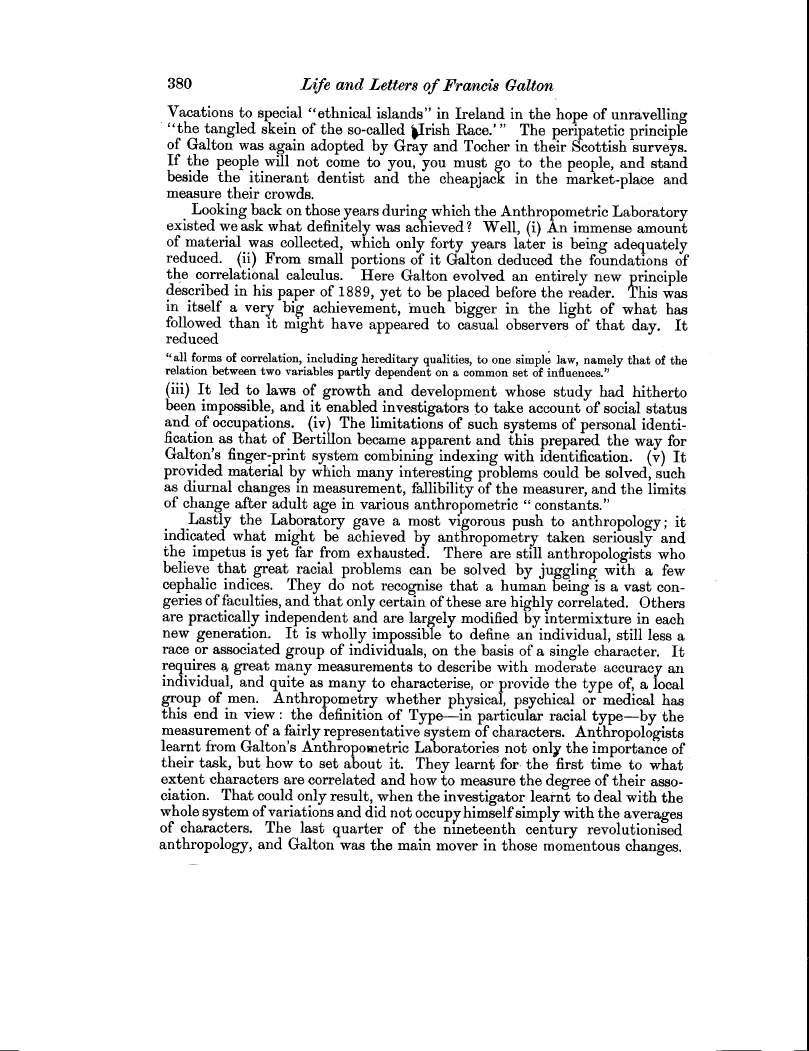380 Life and Letters of Francis Galton
Vacations to special "ethnical islands" in Ireland in the hope of unravelling "the tangled skein of the so-called $Irish Race."' The peripatetic principle of Galton was again adopted by Gray and Tocher in their Scottish surveys. If the people will not come to you, you must go to the people, and stand beside the itinerant dentist and the cheapjack in the market-place and measure their crowds.
Looking back on those years during which the Anthropometric Laboratory existed we ask what definitely was achieved? Well, (i) An immense amount of material was collected, which only forty years later is being adequately reduced. (ii) From small portions of it Galton deduced the foundations of the correlational calculus. Here Galton evolved an entirely new principle described in his paper of 1889, yet to be placed before the reader. This was in itself a very big achievement, much bigger in the light of what has followed than it might have appeared to casual observers of that day. It reduced
"all forms of correlation, including hereditary qualities, to one simple law, namely that of the relation between two variables partly dependent on a common set of influences."
(iii) It led to laws of growth and development whose study had hitherto been impossible, and it enabled investigators to take account of social status and of occupations. (iv) The limitations of such systems of personal identification as that of Bertillon became apparent and this prepared the way for Galton's finger-print system combining indexing with identification. (v) It provided material by which many interesting problems could be solved, such as diurnal changes in measurement, fallibility of the measurer, and the limits of change after adult age in various anthropometric " constants."
Lastly the Laboratory gave a most vigorous push to anthropology ; it indicated what might be achieved by anthropometry taken seriously and the impetus is yet far from exhausted. There are still anthropologists who believe that great racial problems can be solved by juggling with a few cephalic indices. They do not recognise that a human being is a vast congeries of faculties, and that only certain of these are highly correlated. Others are practically independent and are largely modified by intermixture in each new generation. It is wholly impossible to define an individual, still less a race or associated group of individuals, on the basis of a single character. It requires a great many measurements to describe with moderate accuracy an individual, and quite as many to characterise, or provide the type of, a local group of men. Anthropometry whether physical, psychical or medical has this end in view : the definition of Type-in particular racial type-by the measurement of a fairly representative system of characters. Anthropologists learnt from Galton's Anthropometric Laboratories_ not only the importance of their task, but how to set about it. They learnt for- the first time to what extent characters are correlated and how to measure the degree of their association. That could only result, when the investigator learnt to deal with the whole system of variations and did not occupy himself simply with the averages of characters. The last quarter of the nineteenth century revolutionised anthropology, and Galton was the main mover in those momentous changes.

